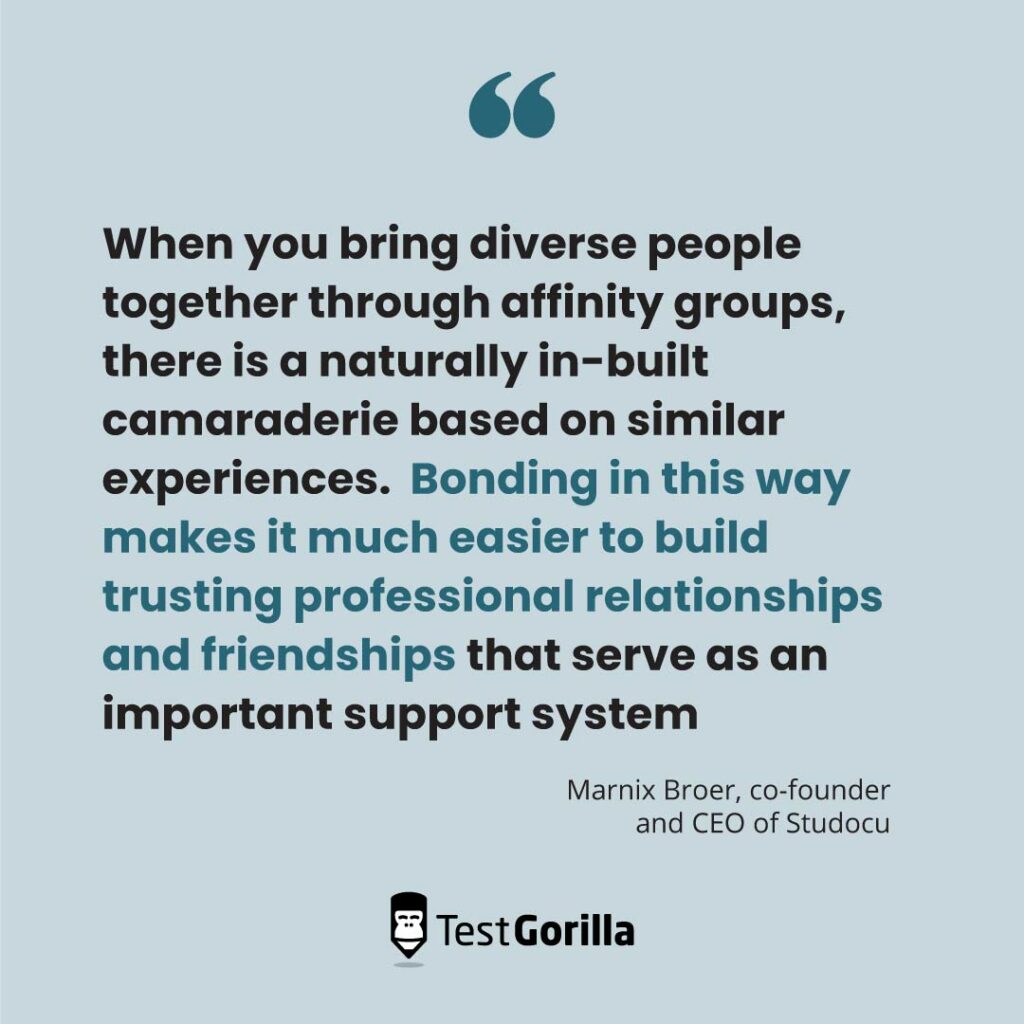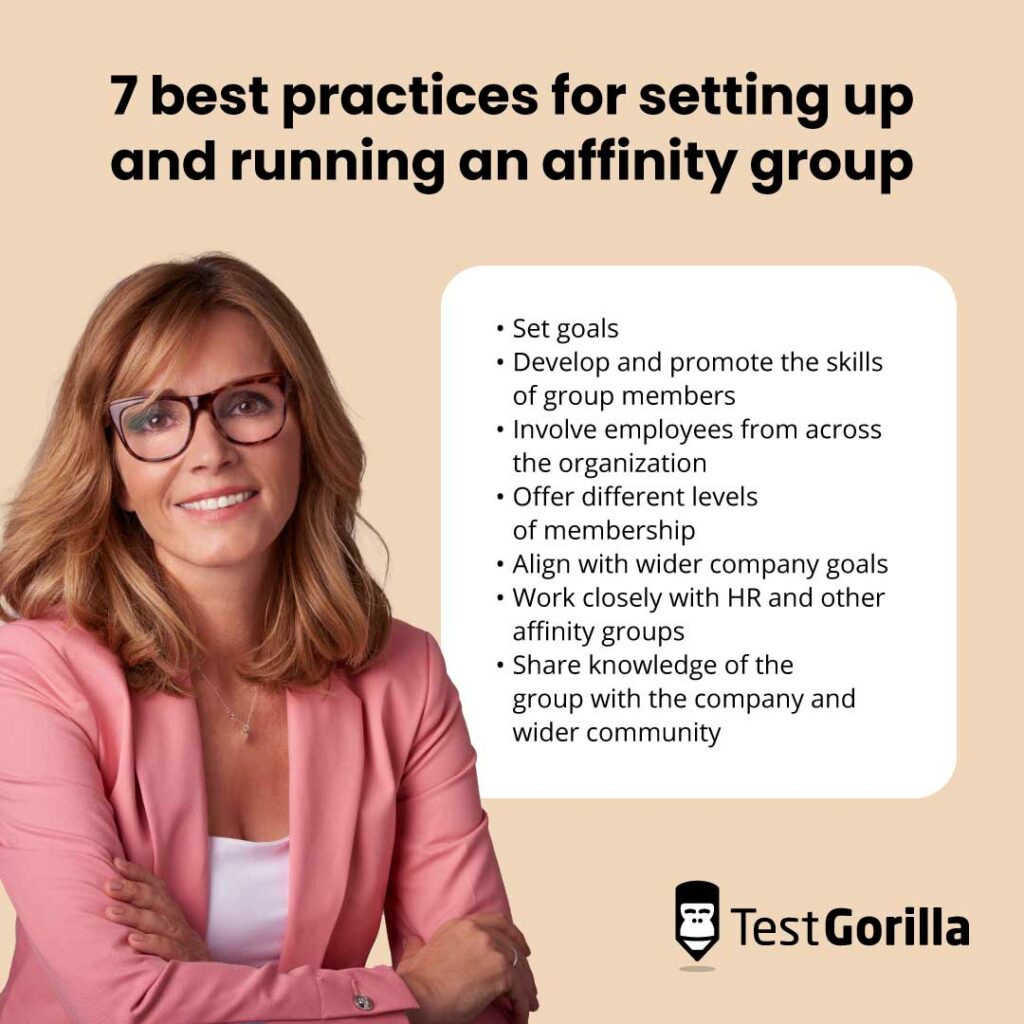Give me an ‘A’: How Affinity Groups improve retention of diverse teams
An estimated 90% of Fortune 500 companies have formed affinity groups.[1] Also known as employee resource groups (ERGs), these are voluntary, employee-led groups designed to promote an inclusive, diverse, and supportive workplace.
They have the potential to improve employee engagement and play an important role in business strategy and operations.
By giving employees a safe space to have open discussions about diversity and inclusion (D&I), these groups give people the courage to open up about the issues that affect them and hold them back at work.
In this article, we’ll look at how affinity groups can help improve retention rates through mentorship and support. We’ll also discuss how these groups provide an opportunity to address bias across an organization, foster a positive employee experience, and encourage the retention of diverse teams.
We’ll list some best practices for setting up an affinity group to make sure it works for the employees who need it most. We’ll also demonstrate how to use talent assessments to help members achieve their ambitions of moving into leadership roles.
Table of contents
A space to be yourself: 6 benefits of affinity groups
Establishing affinity groups creates a supportive and inclusive space for employees to express their unique identities.
Anthony Martin, founder and chief executive of Choice Mutual, explains: “Affinity groups offer twofold benefits to help women, LGBTQ+, and other underrepresented groups land more promotions and climb their way up the senior leadership ladder.”
Firstly, members don’t have to rely solely on their own knowledge and experience. They can ask teammates for advice and support, and get guidance through the promotion process.
Secondly, affinity groups help employers create a fairer hiring and promotion process. By working directly with HR and leaders, affinity group members can get employers to “stop, listen, and change for the better.”
Let’s turn to the benefits of affinity groups.
Create a sense of community
Affinity groups can help individuals from diverse backgrounds feel less different and alone in the workplace.
Marnix Broer, co-founder and CEO of Studocu, says: “When you bring diverse people together through affinity groups, there is a naturally in-built camaraderie based on similar experiences. Bonding in this way makes it much easier to build trusting professional relationships and friendships that serve as an important support system.”
With 51% of employees having left a job because they didn’t feel a sense of belonging, affinity groups are crucial to establishing strong team connections.
Improve diversity and inclusion
Being intentional about diversity is more achievable when it’s ingrained from the beginning.
To demonstrate to potential employees that a welcoming environment awaits them, HR teams can involve affinity group representatives in the interview process. Showcasing the organization’s commitment to D&I sends a powerful and positive message to potential employees.
Additionally, affinity groups often organize events, workshops, and discussions that promote education and awareness about different cultures, identities, and perspectives. Active engagement in these activities helps employees gain a deeper understanding of D&I issues — fostering empathy, respect, and a more inclusive work environment.
When HR takes a proactive approach, the benefits of D&I extend across departments and the entire organization.
Peer support and mentoring
Employees from diverse backgrounds may feel more comfortable talking about their struggles within the safe space of an affinity group.
“Since these groups are employee-led by diverse teammates, leadership doesn’t have to guess how best to approach each topic or challenge. Rather than having leadership take a top-down approach to connect the group, its members, who actually have diverse experiences, decide on the group’s direction. Affinity groups give diverse employees a voice and the support of their peers to gain the confidence to use it.”
Jack Underwood, chief executive and co-founder of Circuit
Peer support and mentoring programs contribute to a more inclusive organizational culture by breaking down silos, fostering collaboration, and promoting empathy. These initiatives encourage employees to learn from diverse perspectives, challenge biases, and cultivate a greater appreciation for the strengths and contributions of colleagues from different backgrounds.
Improve employee retention
Companies that prioritize the involvement of affinity groups in their D&I efforts are more likely to attract and retain diverse talent.
Jack says: “Women, people of color, and other diverse teammates are often more comfortable discussing struggles with an affinity group because they know there is already an established understanding. With shared experiences, group members don’t simply sympathize but empathize and relate to them.”
Affinity groups offer a range of benefits that contribute to increased retention rates. First and foremost, they provide support networks for employees, allowing them to build relationships that help guide them through their career journeys. These networks can be particularly valuable for employees who may otherwise feel isolated or marginalized.
This level of support motivates employees and gives them a strong sense of belonging, which will make them more likely to stay in their roles.
Offer upskilling and reskilling
Affinity groups provide employees from underrepresented groups with a comfortable environment and the tools and resources to:
Enhance their skills
Adapt to evolving job requirements
Pursue new career paths
By providing upskilling and reskilling opportunities, organizations demonstrate their commitment to investing in the professional growth and development of all employees.
For example, affinity groups offer opportunities for women to attend specific women in leadership seminars. These opportunities can provide women with the confidence to speak up and negotiate in the workplace.
According to a Harvard Business Review report: “American culture often discourages women — especially women of color (WOC) — from self-advocating, particularly when it comes to grasping greater power and resources or saying no to undervalued work. It’s common to hear WOC report feeling the instinct to stay silent and be grateful for what they have. They also often report a reasonable fear of backlash if they strive beyond others’ expectations or push back on additional workplace asks.”[2]
Removing the barriers for individuals from underrepresented backgrounds in this way encourages their advancement and helps to level the playing field. It also mitigates the impact of skills gaps and ensures a diverse talent pool that can contribute to innovation and adaptability within the organization.
Advocate for change
Affinity groups can serve as advocates for change within an organization. Group members can actively work to challenge biases, dismantle systemic barriers, and promote equality and mutual respect in the workplace. They also initiate conversations, facilitate dialogues, and educate their colleagues about the importance of creating an inclusive environment.
Through collaboration with leadership and HR departments, affinity teams can help create, develop, and implement strategies that address diversity gaps, promote inclusive hiring practices, and foster a culture of belonging.
By holding themselves and others accountable, advocates for change create a culture where everyone feels valued, respected, and empowered to bring their authentic selves to work.
7 best practices for setting up and running an affinity group
Here are seven best practices to ensure your affinity group can thrive:
Set goals
By clearly defining the purpose and scope of the affinity group, you can determine which activities the group should focus on. This is crucial both to ensure measurable outcomes and to align with your organization’s D&I strategy.
Rather than just existing for the sake of it, affinity groups need a solid purpose. For example, a group may focus on providing support for younger people of color and offering mentoring support from senior team members. This way, group members can benefit from the knowledge and wisdom of colleagues who have been in the same position as them and understand the specific challenges they face.
With firm goals in place, affinity groups can plan to raise money for activities that will benefit their members, such as participation in the Colours Youth Festival or Neurodiversity Celebration Week.
Develop and promote the skills of group members
Research shows that organizations with diverse leadership can outperform those that do not by as much as 48%.
An affinity group can focus on the professional growth and development of members to unlock their skills.
This can include organizing workshops, seminars, or mentorship programs that help members enhance their skills, expand their knowledge, and advance their careers. For example, an affinity group for women of color can encourage their members to try out talent assessments for leaders with the aim of helping members achieve their ambitions of moving into leadership roles.
Affinity groups can also use skills-based assessments as a way of identifying training gaps and opportunities. By conducting assessments, you can gather data and insights about the skills and knowledge levels of group members. This meaningful information can inform the design and implementation of targeted training and development programs.
Affinity groups can use the following tests to identify training gaps and opportunities:
Critical thinking test to recognize individuals who can evaluate information and make sound judgments using analytical skills. Leadership & people management test for identifying leaders who can support and develop others. Verbal reasoning test to evaluate someone’s ability to recognize logical relationships between words and draw accurate conclusions from written information.
Involve employees from across the organization
For an affinity group to be successful, it’s vital to generate interest and awareness across various departments. Doing so encourages broader perspectives and fosters cross-functional support resulting in better communication, cooperation, and understanding among members.
Involving employees from across the organization also strengthens the collective voice of group members and enables the development of more effective strategies to create an inclusive workplace for everyone.
To achieve this, actively promote the affinity group and its activities throughout the organization. Use different communication channels, such as email newsletters, intranet portals, and social media platforms, to raise awareness and generate interest. Highlight the benefits and opportunities that the affinity group offers — and emphasize how participation can contribute to personal and professional development.
Offer different levels of membership
By designing participation tiers, you can adapt to varying member needs that accommodate active contributors and casual supporters alike.
For example, in an LGBTQ+ inclusion in the workplace affinity group, consider one level for LGBTQ+ employees and another for people who want to be allies. Also known as associate membership, this tier is designed for employees who have a general interest in the affinity group, but may not have the time or capacity to commit fully as core members.
Associates can participate in select group activities and have access to relevant communication channels, resources, and events. While they may not have voting rights, they can still provide valuable input and contribute ideas to the group.
Align with wider company goals
When an affinity group aligns its objectives and initiatives with the broader goals and values of the organization, it strengthens the group’s legitimacy.
It’s important to engage with HR and D&I teams to understand their strategic priorities and initiatives. For example, a company marketing Pride Month should discuss approaches with the relevant affinity group to ensure they remain true to the community.
By engaging in discussions and seeking input from the group itself, the company can ensure that its marketing tactics and activities are aligned with the values and needs of the community, thereby maintaining integrity and authenticity in its approach.
These powerful collaborations are beneficial in two ways – by demonstrating a commitment to inclusivity and fostering stronger relationships between the company and the affinity group.
Work closely with HR and other affinity groups
Ensure your affinity group’s objectives coincide with those of HR and other affinity groups on key topics such as D&I and employee development.
Coordinating initiatives and resources and taking a shared approach to problem-solving will maximize the impact of the affinity group’s efforts on D&I across your organization.
Young Pham, co-founder at BizReport, explains: “Aligning these approaches helps to address underlying biases and opens the debate about D&I — something that leads to learning and awareness, ultimately playing a key role in employee retention.”
While employee affinity groups can help to address issues within an organization, especially as they are based on the identity of a particular group, it’s important that HR maintains responsibility for writing D&I policies and doesn’t place too much responsibility on the shoulders of affinity group members who might not have the expertise or time.[2] Instead, HR can partner with affinity groups and use their valuable insights and perspectives to create robust and well-rounded policies.
“HR is pivotal in helping group leaders develop policies and boundaries for their groups and can serve as a champion for the group to senior leaders. Remember to give credit for innovative business ideas that come from affinity groups.”
Mardia A. Shands, HR and D&I consultant, Mardia A. Shands Consultancy
Share knowledge of the group with the company and wider community
Affinity groups can use their findings and insights to inform talent acquisition strategies. For example, affinity groups for people of color can share information about underrepresented groups with the recruitment team to develop targeted outreach initiatives and attract talent from underserved communities.
This helps attract talent from diverse backgrounds and create a more inclusive workforce.
Affinity groups can also use their influence to create thought leadership content such as articles, blog posts, or social media campaigns. Communicating the group’s accomplishments and activities to the entire organization and the wider community promotes visibility and amplifies success stories.
Case Study: TestGorilla LGBTQ Affinity GroupThe TestGorilla LGBTQ affinity group is an example of how employees with a shared experience can support each other. During the process of setting up the affinity group, the ethos was always to raise some awareness and to encourage all coworkers to be accepting, transparent, and show respect for each other. The TestGorilla LGBTQ affinity group is highlighted as part of the onboarding process so new employees are aware of its existence.The affinity group is run by employees for employees.
“One very powerful thing is that with an affinity group, you can be ‘out’ at different levels. You can be out just with the affinity group, or with the whole company.
Otto Verhage, co-founder and COO at TestGorilla
Empowering diversity through affinity groups
By providing a platform for open dialogue, support, and professional development, affinity groups create a sense of belonging and can be a powerful tool for driving positive change.
They have a positive impact on employee retention by helping individuals build relationships that will support them through their career journey.
They also help create more inclusive work environments, foster professional growth among members, and address the unique challenges faced by underrepresented individuals in the workplace.
To get the most out of your affinity group:
Set clear objectives and goals
Use talent assessments to help members understand their skills and achieve their ambitions
Offer different levels of membership
Align with wider company goals
Work closely with HR and other affinity groups
Share knowledge of your group with the company and the wider community
By understanding the unique experiences and insights of your diverse workforce, you can encourage innovation and create an environment where they’ll feel they belong.
**Want to know how affinity groups can improve your retention of diverse teams?** Discover how skills-based talent assessments can help create an environment where your diverse employees will thrive. Download the State of Skills-Based Hiring 2022 report to learn more
Sources
“Making the Most of Employee Affinity Groups” (2022). HRCI Learning Center. Retrieved June 6, 2023. https://www.hrci.org/community/blogs-and-announcements/hr-leads-business-blog/hr-leads-business/2022/02/14/making-the-most-of-employee-affinity-groups
“Negotiating as a Woman of Color” (2022). _Harvard Business Review._Retrieved June 7, 2023. https://hbr.org/2022/01/negotiating-as-a-woman-of-color
Related posts
You've scrolled this far
Why not try TestGorilla for free, and see what happens when you put skills first.
Latest posts
The best advice on pre-employment testing, in your inbox.
No spam. Unsubscribe at any time.

Hire the best. No bias. No stress.
Our screening tests identify the best candidates and make your hiring decisions faster, easier, and bias-free.
Free resources
This checklist covers key features you should look for when choosing a skills testing platform
This resource will help you develop an onboarding checklist for new hires.
How to assess your candidates' attention to detail.
Learn how to get human resources certified through HRCI or SHRM.
Learn how you can improve the level of talent at your company.
Learn how CapitalT reduced hiring bias with online skills assessments.
Learn how to make the resume process more efficient and more effective.
Improve your hiring strategy with these 7 critical recruitment metrics.
Learn how Sukhi decreased time spent reviewing resumes by 83%!
Hire more efficiently with these hacks that 99% of recruiters aren't using.
Make a business case for diversity and inclusion initiatives with this data.




















